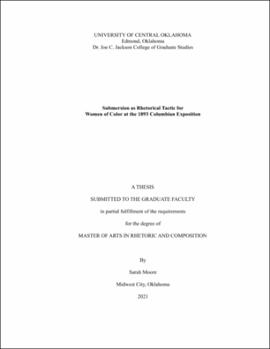| dc.contributor.advisor | Johnson, Cynthia | |
| dc.contributor.author | Moore, Sarah A. | |
| dc.date.accessioned | 2021-12-03T17:03:28Z | |
| dc.date.available | 2021-12-03T17:03:28Z | |
| dc.date.issued | 2021 | |
| dc.identifier.other | (AlmaMMSId)9982799246202196 | |
| dc.identifier.uri | https://hdl.handle.net/11244/331302 | |
| dc.description.abstract | The 1893 Columbian Exposition of the Chicago World’s Fair was a moment meant to showcase the best of the American experience, and many women of color saw this event as an opportunity to voice their message of suffrage for all women that had up until that point been sidelined. Several Black suffragists petitioned for the opportunity to speak at the Columbian Exposition on the issue of women’s suffrage, but the power establishment that controlled access to the Women’s Building declined or ignored all petitions. This flagrant injustice prompted women of color to take matters into their hands and employ a rhetorical tactic that would get them to the podium. Women’s Studies scholars Kimberlé Crenshaw and Laura Behling are both influential to this thesis. Crenshaw’s work with intersectionality and Behling’s insights into the 1893 World’s Fair and its marginalization of women of color created the backbone for this thesis. This thesis argues that due to systematic and unrelenting oppression from the white leadership of the Women’s Building, women of color flooded the media using the rhetorical tactic of submersion. Submersion is a three-component tool that utilizes amplification, circulation, and multimodality. Ultimately women of color were able to speak at a podium in 1893, though it was in the Pavilion of Haiti and not the Women’s Building. It was their successful use of submersion that enabled them in their argument. Rhetorical analysis of speeches and pamphlets from the 1893 World’s Fair were primarily used to conduct this research. Through analysis of previous moments in history, it was found that when submersion was used piecemeal, it was not successful. The 1893 World’s Fair example was successful because submersion was utilized in its full form. This thesis also looks at contemporary examples of successful submersion. Suggestions for future research include further analysis of the Women’s Suffrage Movement for evidence of submersion outside the 1893 Columbian Exposition. | en_US |
| dc.rights | All rights reserved by the author, who has granted UCO Chambers Library the non-exclusive right to share this material in its online repositories. Contact UCO Chambers Library's Digital Initiatives Working Group at diwg@uco.edu for the permission policy on the use, reproduction or distribution of this material. | |
| dc.subject.lcsh | African American women suffragists | |
| dc.subject.lcsh | Illinois | |
| dc.subject.lcsh | Chicago | |
| dc.subject.lcsh | History | |
| dc.subject.lcsh | 19th century | |
| dc.subject.lcsh | Rhetoric | |
| dc.subject.lcsh | Political aspects | |
| dc.title | Submersion as rhetorical tactic for women of color at the 1893 Columbian Exposition | en_US |
| dc.type | Academic theses | |
| dc.contributor.committeeMember | Similly, Leslie | |
| dc.contributor.committeeMember | Dumin, Laura M. | |
| dc.thesis.degree | M.A., English - Rhetoric and Composition | |
| dc.subject.keywords | 1893 Columbian Exposition | |
| dc.subject.keywords | Black suffragists | |
| dc.subject.keywords | Women's suffrage movement | |
| dc.subject.keywords | Rhetoric | |
| dc.subject.keywords | American history | |
| dc.subject.keywords | Women's studies | |
| dc.subject.keywords | Black studies | |
| dc.subject.keywords | Public policy | |
| dc.identifier.oclc | (OCoLC)1287946057 | |
| thesis.degree.grantor | Jackson College of Graduate Studies | |
